Application of nanotechnologies and nanomaterials. Рубрика в журнале - Nanotechnologies in Construction: A Scientific Internet-Journal
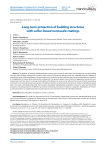
Long-term protection of building structures with sulfur-based nanoscale coatings
Статья научная
The problem of creating reliable protective coatings that increase the mechanical characteristics of concrete building structures (piles, bridges, ceiling arches, tunnels, chutes, culverts, wells, paving slabs and curbs, etc.) operated under the influence of atmospheric factors and groundwater is of great importance. Currently, the most effective way to prevent degradation of materials is the application of various kinds of protective compounds. That protects against various factors of aggressive natural and manmade impact and thus allows increasing the durability of buildings and structures by reducing the amount of water penetrating into the pores. To provide long-term protection of building materials, it is proposed to treat porous surfaces of building materials with a new sulfur-containing compound. The innovative developed impregnating composition is based on sulfur and it provides protection of building materials of different nature from weathering and corrosive media for a long time. Modification of the proposed composition can significantly improve performance and increase the service life of building materials.
Бесплатно
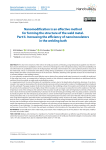
Статья научная
The short-term existence of the melt in the weld pool and its overheating, a large temperature gradient near the interface and two-dimensional crystallization centers, in the form of fused grains at the weld pool boundary, reduce the probability and rate of formation of crystallization centers in the liquid phase. This leads to the formation of a coarse-grained columnar structure of the weld metal, which, in combination with defects arising during crystallization, is less ductile than the fine-grained rolled metal being welded, and often causes brittle fracture of the structure. Therefore, obtaining a fine-grained structure of the weld metal is a constant problem in the welding industry. It is now generally accepted that the most effective way to obtain a fine-grained weld metal structure is to modify the weld pool. At the same time, micro- or nanoparticles of refractory metals or their chemical compounds (inoculators) are introduced into the weld pool from the outside, as ready-made crystallization centers. In a superheated melt, the rate of formation of crystallization centers, due to the deactivation of particles, decreases. It can be increased in two ways: by slowing down the decontamination process and by increasing the number of modifying particles introduced into the weld pool. The paper analyzes the factors that determine the modifying activity of inoculators and methods for maintaining this activity in the weld pool. To ensure high activity of the inoculator, it is necessary to reduce the time of its residence in the hightemperature zone of the weld pool; the material of the inoculator should have high values of temperature and heats of fusion, but lower values of thermal and thermal diffusivity. A decrease in the rate of heating and melting of the inoculator particles is achieved by introducing them into the weld pool, by passing the arc column and the high-temperature zone of the bath, in combination with metal particulates that act as microcoolers and means of transporting the inoculator to the tail of the bath. Nanoscale inoculators have a high thermodynamic potential and the associated high nucleating activity. Inclusions of oxides, carbides and nitrides, on the basis of which crystallization centers are formed, in the solidified metal have strong interatomic bonds with the matrix, and due to the fact that the coefficients of their thermal expansion are an order of magnitude lower than those of the matrix, after cooling the metal, they experience all-round compression. Therefore, such inclusions are not dangerous, are not concentrators of tensile stresses and centers of crack initiation. It is experimentally shown in this work that the introduction of carbon nanotubes with a specific surface area of more than 270 m2/g into the weld pool contributes to the formation of a fine-grained structure of the weld metal.
Бесплатно
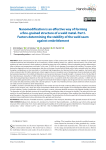
Статья научная
Steel constructions are the most important objects of the construction industry. The main method of connecting individual elements and assemblies of such structures is fusion welding (electric arc, plasma, electron beam). One of the main problems of metal structures is their tendency to brittle fractures that occur suddenly, without noticeable previous deformations, often at below zero temperatures and loads. In this case, 70–80% of such damage is associated with welding. The nature of the destruction depends not only on temperature, but also on the type of crystal lattice. Metals with a body-centered cubic (bcc) lattice (tungsten, molybdenum, α-iron) are plastic at a relatively high temperature, but become brittle when negative. And metals with a face-centered cubic (fcc) lattice (aluminum, nickel, copper and γ-iron) are plastic even at temperatures close to absolute zero. With decreasing temperature, the mobility of dislocations and vacancies decreases, the yield strength σs increases, that is, the ductility of the metal decreases. Using the A.F. Ioffe model showed that the critical temperature of the transition from viscous to brittle fracture with decreasing temperature depends on the rate of increase of σs. In austenitic steels (fcc lattice with a period a = 0.3645 nm), the impurity mobility (paired with a vacancy) through the internode of the lattice is higher, and the growth rate σs is lower than that of low-carbon low alloy steels (bcc lattice with a shorter period a = 0, 2861 nm). Therefore, the low carbon steels from which structures are made are more sensitive to lower temperatures. In addition, resistance to brittle fracture depends on the number and size of metal continuity defects (pores, inclusions, low-plastic phases in the structure, etc.), which are stress concentrators. Welds are the main suppliers of such dangerous defects and sources of crack initiation. During crystallization of the weld pool, a coarse, columnar dendritic structure with reduced ductility is formed. The formation of a fine-grained structure of the weld during crystallization helps to increase its ductility. The grain size in the cast metal (in the weld) depends on the crystal growth rate and the rate of their nucleation. When welding, the most effective way to grind the grain in the seam is to increase the rate of nucleation. The introduction of refractory particles of nanoscale order into the weld pool (nanomodification) allows obtaining a fine-grained weld structure.
Бесплатно
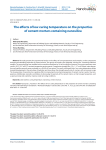
The effects of low curing temperature on the properties of cement mortars containing nanosilica
Статья научная
This study presents the experimental results on the effects of curing temperature and nanosilica, on the compressive strength and absorbing properties of cement mortars. Two groups of mortars were prepared, with the first containing reference samples. The second group was modified with a nanosilica admixture by 3% of the weight of cement. The mortar specimens were cured in 20оC, 10оC and 5оC constant temperature environments. Compressive strength after 12 h, 1, 2, 7 and 28 days, water absorption and capillary porosity were evaluated on a 40×40×40 mm prism. The results confirmed that a low curing temperature delays strength development in the early days of hydration and slows down the strength growth rate of mortars, with an increase in age. The incorporation of nanosilica has a positive effect in improving the mechanical properties of cement mortars cured at low temperatures. Additionally, nanosilica contributes to decreasing the porosity of the cement matrix, so that transport properties, such as open porosity and sorptivity, improve under all curing conditions.
Бесплатно
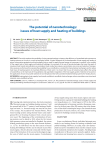
The potential of nanotechnology: issues of heat supply and heating of buildings
Статья научная
The article explores the possibility of using nanotechnology to improve the efficiency of centralized and autonomous heating systems on the way to a new technological model. A logical sequence of the development of heat supply and heating is given, conservative equipment and technologies that are used to supply thermal energy to consumers is marked. In the context of the urgent tasks of heat supply and heating of buildings, the concepts of the use of nanotechnologies that meet the goals of maximum heat transfer intensification are considered. Heat conduction analysis, concentration, size, mass and velocity of nanoparticles assesses are the basis for assessing the possibility to use nanofluids as a coolant for improving heat exchangers and to reduce heat losses in heating systems to maximize efficiency of their work. It is shown that the use of nanostructures affects the saving of coolant flow as the main task of the qualitative and quantitative regulation of the heat supply system. Attention is focused on the application of nano-structured materials in low-temperature fuel cells used decentralized heating systems for heating houses.
Бесплатно

